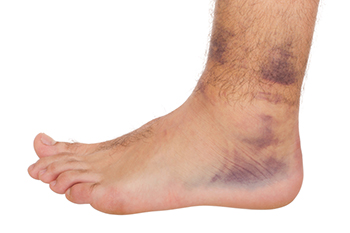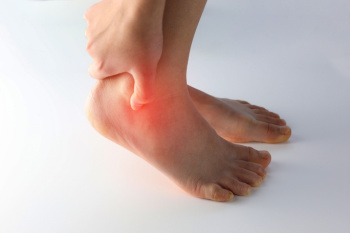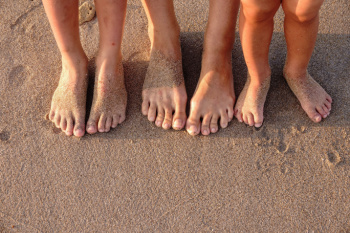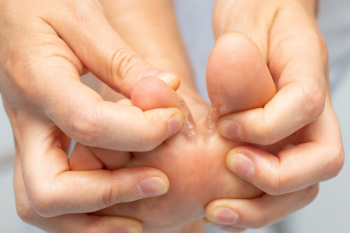Connect With Us
Blog
Items filtered by date: July 2025
Get Professional Care for a Broken Foot or Ankle
Causes and Grades of Ankle Sprains

Ankle sprains are common injuries caused by sudden twisting or rolling of the ankle, often during sports or uneven walking. Inversion sprains affect the outer ligaments of the ankle, while eversion sprains impact the inner ones. Sprains are categorized into three grades. A mild sprain, or Grade 1, causes slight swelling and discomfort. A moderate sprain, or Grade 2, results in partial tearing with pain, bruising, and difficulty walking. A severe sprain, or Grade 3, involves complete tearing of ligaments, significant swelling, and ankle instability. A podiatrist can diagnose the severity, provide targeted treatment, and recommend therapies to restore strength and mobility. If you have sustained an ankle sprain, it is recommended that you schedule an emergency visit with a podiatrist today for a comprehensive evaluation and expert care.
Ankle sprains are common but need immediate attention. If you need your feet checked, contact Katie Besselman, DPM from Advanced Podiatry. Our doctor can provide the care you need to keep you pain-free and on your feet.
How Does an Ankle Sprain Occur?
Ankle sprains take place when the ligaments in your ankle are torn or stretched beyond their limits. There are multiple ways that the ankle can become injured, including twisting or rolling over onto your ankle, putting undue stress on it, or causing trauma to the ankle itself.
What Are the Symptoms?
- Mild to moderate bruising
- Limited mobility
- Swelling
- Discoloration of the skin (depending on severity)
Preventing a Sprain
- Wearing appropriate shoes for the occasion
- Stretching before exercises and sports
- Knowing your limits
Treatment of a Sprain
Treatment of a sprain depends on the severity. Many times, people are told to rest and remain off their feet completely, while others are given an air cast. If the sprain is very severe, surgery may be required.
If you have suffered an ankle sprain previously, you may want to consider additional support such as a brace and regular exercises to strengthen the ankle.
If you have any questions please feel free to contact our office located in Saint Peters, MO . We offer the newest diagnostic and treatment technologies for all your foot and ankle needs.
Reasons Blisters Develop on the Feet

Blisters on the feet usually form when friction or pressure damages the outer layer of skin, causing fluid to build up as a natural protective response. This often happens from shoes that rub, or repetitive movements, such as walking or running long distances. Moisture, heat, and socks that do not allow airflow can make skin more prone to blistering. Other causes include burns, frostbite, allergic reactions, and certain medical conditions like eczema or diabetic neuropathy. Blood blisters may appear when the skin is pinched or crushed, leading to bleeding beneath the surface. Blisters can be painful, especially on weight-bearing areas of the foot, and may limit mobility. It is important not to pop a blister, as breaking the skin can increase the risk of infection. If a blister becomes discolored, swollen, or does not heal, medical attention may be needed. If you frequently develop blisters on your feet, it is suggested that you schedule an appointment with a podiatrist to determine the cause and receive safe and sterile treatment.
Blisters are prone to making everyday activities extremely uncomfortable. If your feet are hurting, contact Katie Besselman, DPM of Advanced Podiatry. Our doctor can provide the care you need to keep you pain-free and on your feet.
Foot Blisters
Foot blisters develop as a result of constantly wearing tight or ill-fitting footwear. This happens due to the constant rubbing from the shoe, which can often lead to pain.
What Are Foot Blisters?
A foot blister is a small fluid-filled pocket that forms on the upper-most layer of the skin. Blisters are filled with clear fluid and can lead to blood drainage or pus if the area becomes infected.
How Do Blisters Form?
Blisters on the feet are often the result of constant friction of skin and material, usually by shoe rubbing. Walking in sandals, boots, or shoes that don’t fit properly for long periods of time can result in a blister. Having consistent foot moisture and humidity can easily lead to blister formation.
Prevention & Treatment
It is important to properly care for the affected area in order to prevent infection and ease the pain. Do not lance the blister and use a Band-Aid to provide pain relief. Also, be sure to keep your feet dry and wear proper fitting shoes. If you see blood or pus in a blister, seek assistance from a podiatrist.
If you have any questions, please feel free to contact our office located in Saint Peters, MO . We offer the newest diagnostic and treatment technologies for all your foot care needs.
Peroneal Tendinopathy Is a Source of Outer Ankle Pain

Peroneal tendinopathy is a condition involving irritation or degeneration of the peroneal tendons, which run along the outer side of the ankle and foot. These tendons help stabilize the foot and support balance during walking or running. Causes include overuse, improper footwear, high-impact activities, or ankle instability. Symptoms include aching or sharp pain along the outer ankle, swelling, weakness, or a feeling of instability. Without treatment, the condition may worsen and limit mobility. A podiatrist can evaluate the problem through physical examination and imaging, then provide care with rest plans, bracing, or custom orthotics. If you experience persistent outer ankle pain, it is suggested that you visit a podiatrist for a tailored treatment plan and long-term relief.
Ankle pain can have many different causes and the pain may potentially be serious. If you have ankle pain, consult with Katie Besselman, DPM from Advanced Podiatry. Our doctor will assess your condition and provide you with quality foot and ankle treatment.
Ankle pain is any condition that causes pain in the ankle. Due to the fact that the ankle consists of tendons, muscles, bones, and ligaments, ankle pain can come from a number of different conditions.
Causes
The most common causes of ankle pain include:
- Types of arthritis (rheumatoid, osteoarthritis, and gout)
- Ankle sprains
- Broken ankles
- Achilles tendinitis
- Achilles tendon rupture
- Stress fractures
- Tarsal tunnel syndrome
- Plantar fasciitis
Symptoms
Symptoms of ankle injury vary based upon the condition. Pain may include general pain and discomfort, swelling, aching, redness, bruising, burning or stabbing sensations, and/or loss of sensation.
Diagnosis
Due to the wide variety of potential causes of ankle pain, podiatrists will utilize a number of different methods to properly diagnose ankle pain. This can include asking for personal and family medical histories and of any recent injuries. Further diagnosis may include sensation tests, a physical examination, and potentially x-rays or other imaging tests.
Treatment
Just as the range of causes varies widely, so do treatments. Some more common treatments are rest, ice packs, keeping pressure off the foot, orthotics and braces, medication for inflammation and pain, and surgery.
If you have any questions, please feel free to contact our office located in Saint Peters, MO . We offer the newest diagnostic and treatment technologies for all your foot care needs.
Summer Foot Habits to Avoid

Warm weather often leads to wearing lighter footwear and more time outside, but certain habits can put your feet at risk. Spending extended periods of time walking barefoot, even around pools or on grass, may result in injuries or infections. Thin sandals without proper structure can lead to heel pain or arch strain. Damp feet left in wet shoes or socks may invite fungus and skin irritation. Forgetting to protect the tops of your feet from the sun can result in unexpected burns. Cutting toenails improperly or too short in preparation for open-toed shoes may cause painful nail problems. While summer encourages a relaxed approach, your feet still need support, protection, and care. Being mindful of how you treat your feet during this season can help prevent avoidable issues. If your feet become sore, irritated, or develop problems that do not improve, it is suggested that you see a podiatrist for a proper diagnosis and appropriate treatment.
Foot Pain
Foot pain can be extremely painful and debilitating. If you have a foot pain, consult with Katie Besselman, DPM from Advanced Podiatry. Our doctor will assess your condition and provide you with quality foot and ankle treatment.
Causes
Foot pain is a very broad condition that could be caused by one or more ailments. The most common include:
- Bunions
- Hammertoes
- Plantar Fasciitis
- Bone Spurs
- Corns
- Tarsal Tunnel Syndrome
- Ingrown Toenails
- Arthritis (such as Gout, Rheumatoid, and Osteoarthritis)
- Flat Feet
- Injury (from stress fractures, broken toe, foot, ankle, Achilles tendon ruptures, and sprains)
- And more
Diagnosis
To figure out the cause of foot pain, podiatrists utilize several different methods. This can range from simple visual inspections and sensation tests to X-rays and MRI scans. Prior medical history, family medical history, and any recent physical traumatic events will all be taken into consideration for a proper diagnosis.
Treatment
Treatment depends upon the cause of the foot pain. Whether it is resting, staying off the foot, or having surgery; podiatrists have a number of treatment options available for foot pain.
If you have any questions, please feel free to contact our office located in Saint Peters, MO . We offer the newest diagnostic and treatment technologies for all your foot care needs.
Signs and Treatment of Athlete’s Foot

Athlete’s foot is a fungal infection that affects the skin between toes, underneath the soles, and around the ankles. Athlete's foot often causes itching, scaling, cracking, and occasional discomfort due to inflammation and moisture buildup in the foot's natural crevices. In some cases, small blisters may appear, and skin may fissure, especially in areas subject to friction from shoes or socks. When left untreated, the infection can spread across the foot and create openings that allow bacteria to enter, increasing the risk of secondary infection. A podiatrist can evaluate the extent of the infection, identify secondary complications, and recommend an appropriate course of treatment to restore skin integrity. This may involve debriding thickened skin, prescribing appropriate topical or systemic antifungal agents, and advising on footwear modifications to reduce moisture and friction. If you have developed an athlete's foot infection that has become problematic, it is suggested that you schedule an appointment with a podiatrist for appropriate treatment.
Athlete’s foot is an inconvenient condition that can be easily reduced with the proper treatment. If you have any concerns about your feet and ankles, contact Katie Besselman, DPM from Advanced Podiatry. Our doctor will treat your foot and ankle needs.
Athlete’s Foot: The Sole Story
Athlete's foot, also known as tinea pedis, can be an extremely contagious foot infection. It is commonly contracted in public changing areas and bathrooms, dormitory style living quarters, around locker rooms and public swimming pools, or anywhere your feet often come into contact with other people.
Solutions to Combat Athlete’s Foot
- Hydrate your feet by using lotion
- Exfoliate
- Buff off nails
- Use of anti-fungal products
- Examine your feet and visit your doctor if any suspicious blisters or cuts develop
Athlete’s foot can cause many irritating symptoms such as dry and flaking skin, itching, and redness. Some more severe symptoms can include bleeding and cracked skin, intense itching and burning, and even pain when walking. In the worst cases, Athlete’s foot can cause blistering as well. Speak to your podiatrist for a better understanding of the different causes of Athlete’s foot, as well as help in determining which treatment options are best for you.
If you have any questions please feel free to contact our office located in Saint Peters, MO . We offer the newest diagnostic and treatment technologies for all your foot and ankle needs.




